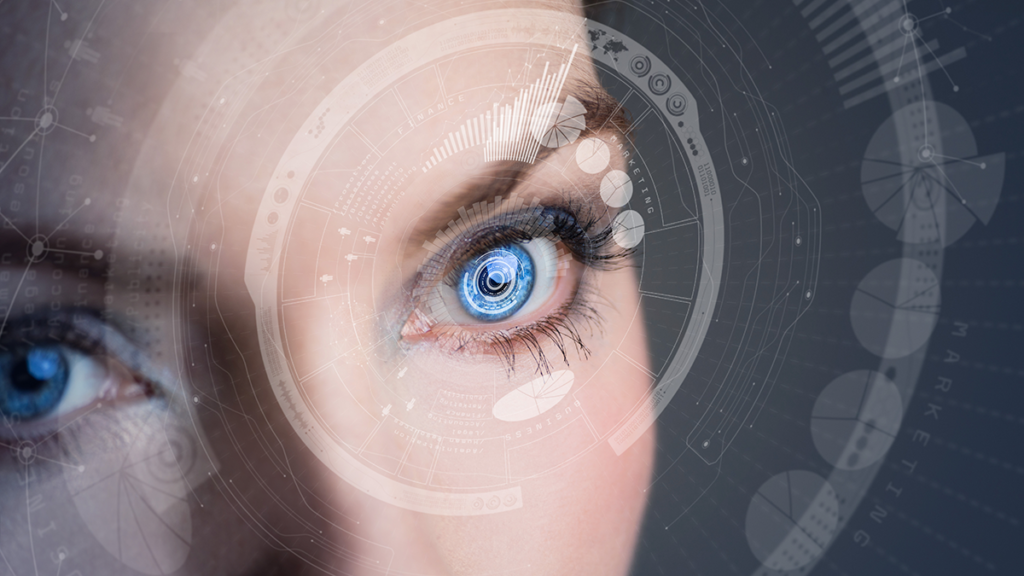Smart eye tracking technology can be used for a multitude of applications. Here, IoT Insider explores specifically the use cases of smart eye technology for marketing purposes and medical applications.
Smart contact lenses
Smart contact lenses, although still in development, have the potential to change eyecare forever. With the possibility of zooming in, taking photos and recording video footage, and even helping with eye conditions such as glaucoma or monitoring glucose in diabetes patients, scientists and large technological corporations are currently developing such a thing.
In 2011, Microsoft collaborated on a research project with the University of Washington to design a contact lens with a sensor that was able to monitor the glucose levels of the wearer. The technology has the aim of assisting people with diabetes with blood sugar level monitoring.
Since then, prototypes have included different types of sensors, microelectronics and types of wireless transmissions, but technologies are still being developed for smart contact lenses.
Smart contact lenses could help manage the give most prominent eye conditions: cataracts, glaucoma, diabetic retinopathy, macular degeneration and retinal detachment. They can monitor physiological information of tear and eye fluid to provide medical diagnostics.
The global smart contact lenses market is expected to reach $2.8bn by 2025, indicating that R&D will continue to progress in the smart contact lens industry. In the meantime, pharmaceutical and tech companies face several challenges. These include the fact that smart lenses will need to remain thin enough to fit over the eye comfortably whilst encapsulating tiny sensors and microelectronics inside, able to supply enough power to work effectively. Another key challenge is reliability, in terms of for this specific application, the technology must remain reliable to help doctors with diagnosis and to improve patient treatment plans.
These challenges, and more must be addressed before smart contact lenses become widely available.
VisusNano
VisusNano, a med-tech company, has developed its MEDILens, a drug-eluting intraocular lens implant (IOL) for use in patients undergoing cataract surgery.
Cataract is the most common cause of treatable blindness, treated with surgery however this still poses the risk of inflammation and pain, and loss off vision if left untreated. Currently, inflammation is prevented with administration of eye drops for up to a month, with significant cost to the NHS. Specifically, 400,000 cataract operations are carried out in the UK annually, with aftercare placing a £55m burden each year on NHS services.
There is a desire from cataract surgeons and patients to use a drug-eluting implant to eliminate the need for these post-operative regimens. MEDILens’ ability to release anti-inflammatory drugs into the eye removes the need to administer eye drops.
AI and marketing
Another application for smart eye technology is to predict consumer responses and behaviour. Neurons considers itself a consumer neuroscience company. It uses true emotional and attention artificial intelligence to predict customer responses and choice. Based on behavioural research, its solutions harness the power of neuroscience and AI, Neurons helps businesses predict, understand and adapt to customer decision-making processes.
It employs research methodologies to generate actionable insights from neuroscience to improve business and society. Neurons has tools and insights to help companies ensure their marketing campaigns, brand strategy and brand design is as attractive as possible to consumers, and their call to actions are appealing. This is by utilising eye tracking technology to identify where people are looking at on different creative assets, including websites, billboards, and video.
Its tools and insights can help companies ensure their adverts aren’t ignored, helping with brand optimisation.
Neurons measures four key neuro metrics: attention, emotion, memories and cognitive load by using two different tools. Its predictable tool uses traditional eye tracking technology in a cloud-based environment using machine learning artificial intelligence. Clients can upload their assets that they want to carry out pre-testing on. Clients can upload their assets and receive analysis in seconds, ensuring key messaging is seen at the optimal amount of focus.
Other applications
From screen based eye trackers, eye tracking glasses and webcam eye tracking, there are plenty of other applications of smart eye tracking technology. One of the main benefits of such technology is it can be used to record and analyse visual behaviour objectively and accurately.
